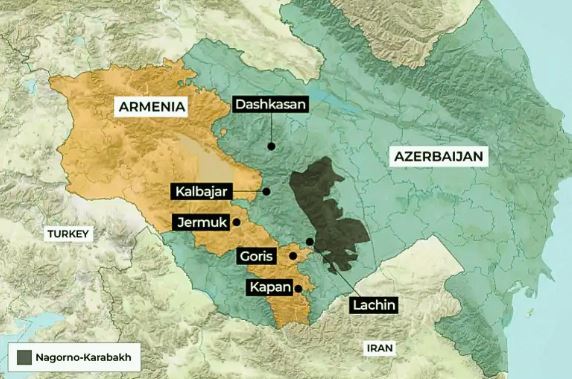Armenia and Azerbaijan Move Towards Normalizing Ties with First Border Marker
Armenia and Azerbaijan have placed the first border marker, following a bitter conflict over the Nagorno-Karabakh region. Experts from both countries are working on demarcating their boundaries as part of the peace process. The two nations are working towards a peace treaty after Azerbaijan regained full control of the Nagorno-Karabakh region that had been under the control of ethnic Armenian forces since the 1990s.
Background of the Conflict
- Nagorno-Karabakh, a region within Azerbaijan, has been a point of contention between Armenia and Azerbaijan since the collapse of the Soviet Union.
- The region, largely populated by ethnic Armenians, declared independence from Azerbaijan in 1991, leading to a war that lasted until 1994.
- A ceasefire was signed in 1994, but sporadic clashes continued over the years.
Recent Developments
- In 2020, a six-week war resulted in Azerbaijan retaking large parts of the breakaway region.
- In September 2023, Azerbaijani forces launched a lightning blitz that forced Nagorno-Karabakh’s Armenian authorities to capitulate in negotiations mediated by Russian forces.
- Several days ago, Armenia and Azerbaijan reached an agreement over a stretch of border that would cut through four Armenian villages in the Tavush province, meaning that Armenia would cede some territory to Azerbaijan.
Protests in Armenia
- The border demarcation process has faced resistance from many residents of Armenia’s border regions, who see it as Azerbaijan’s encroachment on areas they consider their own.
- Protests erupted in Armenia, with demonstrators blocking roads in the northeastern region that the proposed border would run through, as well as along two key routes elsewhere in the country.
Progress Towards Peace
- Despite the protests, Azerbaijani President Ilham Aliyev said that Baku and Yerevan were edging closer to a common understanding of what a peace agreement might look like.
- Armenia’s Prime Minister Nikol Pashinyan has emphasized the need to quickly define the border with Azerbaijan to avoid further hostilities.
Russian Peacekeeping Forces
- Russia began withdrawing its peacekeeping forces from Nagorno-Karabakh in April 2024, after being stationed there under a truce brokered by Moscow that ended the 2020 war.
- The peacekeepers’ duties included ensuring free passage on the sole road connecting Nagorno-Karabakh with Armenia, but Azerbaijan began blocking the road in late 2022, alleging misuse by Armenians.
Displacement and Realism
- After Azerbaijan regained full control of Nagorno-Karabakh, the vast majority of its nearly 120,000 population fled to Armenia.
- Prime Minister Pashinyan has called for realism in the face of the wide gap between the Armenian and Azerbaijani militaries, acknowledging that the return of displaced Armenians to Nagorno-Karabakh may not be realistic given the current situation.
The installation of the first border marker represents a significant step towards normalizing relations between Armenia and Azerbaijan. However, the process is likely to face further challenges as both nations navigate the complex issues surrounding the Nagorno-Karabakh region and work towards a lasting peace.
Month: Current Affairs - April, 2024
Category: International / World Current Affairs








